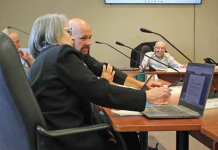While County council will discuss the draft shoreline preservation bylaw at a special meeting yet to be scheduled, stakeholders have had a week to pour over the consultants’ final draft.
The Haliburton County Home Builders Association (HCHBA) said in a written statement they’re “pleased with the progress” that’s been made but are concerned about proposed site alteration permitting processes.
“The requirements for this process are far too extensive, time-consuming, and costly,” wrote Aggie Tose of the HCHBA.
“The HCHBA is also concerned with time delays to receive approvals. Currently, our local building departments are overloaded and are having a hard time keeping up with the demand. How many more County or municipal employees will be required to make sure this application process operates efficiently and effectively?”
At council’s Oct. 27 meeting, Algonquin Highlands mayor Carol Moffatt said recommendations in the draft need to be paired with a discussion of “who, and with what money, and under what timeline” the bylaw would be implemented and enforced.
“In order to really discuss sort of what resources are required to implement a bylaw we really need a firmer understanding of what will be in the bylaw,” said County CAO Mike Rutter.
Schedule ‘A’ of the draft bylaw outlines a permitting system that would be handled by municipal building departments.
It contains fewer precise requirements than previously suggested in a Countydeveloped draft tabled in Jan. 2021.
Landowners would not have to provide the location of soil or material stockpiles on a site nor the location and dimensions of staging areas for heavy machinery. The permit requirements can be waived if planning officials judge the work’s impact to be minimal.
The draft states all major construction and site alteration activities “will be required to apply for and receive permit approval before such significant projects and activity are undertaken in the buffer area” of 30 metres from a shoreline’s high watermark. It also establishes opportunities for residents to speak to council when permits are not approved or delayed.
Concerned Haliburton Waterfront Property Owners, an unofficial group of more than 160 cottage owners, have advocated for a smaller setback of 10 metres, a buffer that peer-reviewed research estimates would eliminate 65 per cent of sediment. The group also lobbies for a less onerous permit system.
“Before this schedule is finalized,” states the group’s written response to the draft, “we strongly encourage County officials to meet with the representatives of the homebuilders, landscapers and site services companies to negotiate better requirements in Schedule A that aren’t unnecessarily difficult, expensive or inflexible.”
Other permitting requirements include documenting existing topography of the site and land within 30 metres of the site, and the locations and dimensions of stormwater management or drainage systems such as ditches and roads within 30 metres of the site.
Environment Haliburton! president Terry Moore, instrumental in the Love your Lakes lake health monitoring project, has studied the environmental impact of development on Haliburton’s watersheds for years. He said the permitting approach looks to be far more effective than an after-the-fact complaint system.
“Hopefully this bylaw will begin to alter what is happening on the shoreline, and we’ll be able to save more, stop the erosion of natural shorelines and restore what we’ve lost so far,” said Moore.
Moore added that the County’s official plan already indicates a minimum setback of 30 metres from the water.
The document states that “development and site alterations shall be set back a minimum of 30 metres from the high watermark of lakes, rivers and streams.”
Unlike the previously proposed draft, the bylaw currently on the table suggests a shoreline buffer of fewer than 30 metres can be permitted if it’s not possible for reasons such as lot depth.
The HCHBA said it’s “confident there will be more opportunities to speak with council ahead of the bylaw being passed. HCHBA is looking forward to continuing this process and reaching an effective and amicable conclusion.”




